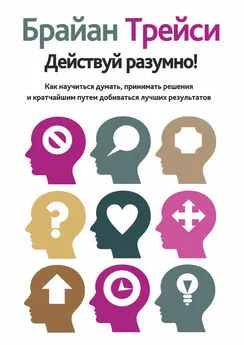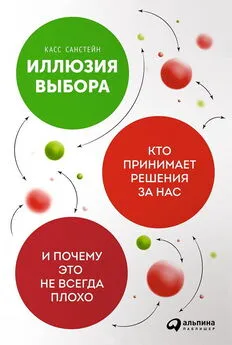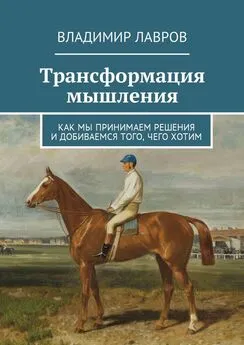Джона Лерер - Как мы принимаем решения
- Название:Как мы принимаем решения
- Автор:
- Жанр:
- Издательство:ООО “Издательство Астрель” CORPUS
- Год:2011
- Город:Москва
- ISBN:978-5-271-26397-2
- Рейтинг:
- Избранное:Добавить в избранное
-
Отзывы:
-
Ваша оценка:
Джона Лерер - Как мы принимаем решения краткое содержание
Каждое мгновение мы принимаем решения: от очень важных до малозначимых и повседневных. Именно это свойство — умение делать свободный выбор — и делает человека человеком. Но как это происходит? Как работает мозг, в доли секунды обрабатывающий колоссальный объем информации? Как соотносятся разум и интуиция? Эти вопросы занимают не только философов и нейрофизиологов, но и каждого из нас.
Джона Лерер, американский журналист и всемирно известный популяризатор науки, не только увлекательно описывает, как устроен механизм принятия решений. Книга «Как мы принимаем решения» рассказывает и о том, как происходит процесс выбора, и одновременно помогает сделать этот процесс эффективнее.
Как мы принимаем решения - читать онлайн бесплатно полную версию (весь текст целиком)
Интервал:
Закладка:
Hogarth, Robin. Educating Intuition. Chicago: University of Chicago Press, 2001.
Holden, Anthony. Big Deal: A Year as a Professional Poker Player. New York: Simon and Schuster, 2007.
Hollerman, Jeffrey, and Wolfram Schultz. Dopamine Neurons Report an Error in the Temporal Prediction of Reward during Learning. Nature Neuroscience 1 (1998):304 —09.
Homer-Dixon, Thomas. The Ingenuity Gap. New York: Vintage, 2002. Inman, J. Jeffrey, Leigh McAlister, and Wayne Hoyer. Promotion Signal: Proxy for a Price Cut? Journal of Consumer Research 17 (1990): 74–81.
Ito,S., et al. Performance Monitoring by the Anterior Cingulate Cortex During Saccade Countermanding. Science 302 (2003): 120— 22.
James, William. The Principles of Psychology. Vol. 2. New York: Dover, 1950.
Jarvik, Jeffrey, et al. Rapid Magnetic Resonance Imaging versus Radiographs for Patients with Low Back Pain. Journal of the American Medical Association 289 (2003): 2810—18.
Jefferson, Thomas. The Writings of Thomas Jefferson. Washington, DC: Lipscomb and Bergh, 1903.
Jensen, Maureen, Michael N. Brant-Zawadzki, Nancy Obuchowski, MichaelT. Modic, Dennis Malkasian, and JeffreyS. Ross. Magnetic Resonance Imaging of the Lumbar Spine in People without Back Pain. New England Journal of Medicine 331 (1994): 69— 73.
Juckel, G., et al. Dysfunction of Ventral Striatal Reward Prediction in Schizophrenia. Neuroimage 29 (2006): 409—16.
Jung-Beeman, Mark, et al. Neural Activity Observed in People Solving Verbal Problems with Insight. Public Library of Science — Biology 2 (2004):500—10.
Kahneman, Daniel, et al., EDS. Judgment under Uncertainty: Heuristics and Biases. Cambridge: Cambridge University Press, 2000.
Kahneman, Daniel, and Amos Tversky. Prospect Theory: An Analysis of Decision under Risk. Econometrica 47 (1979): 263—91.
Kahneman, Daniel, and Amos Tversky, eds. Choices, Values, and Frames. Cambridge: Cambridge University Press, 2002.
Kandel, Eric, et al. Principles of Neural Science. New York: McGraw Hill, 1999.
Keltner, Dacher. The Power Paradox. Greater Good 4 (Winter 2007–2008).
Kennerley, Steven, et al. Optimal Decision-Making and the ACC. Nature Neuroscience 9 (2006): 940—47.
Kermer, D. A., Erin Driver-Linn, Timothy Wilson, and Daniel Gilbert. Loss Aversion Is an Affective Forecasting Error. Psychological Science 17 (2006): 649—53.
Klein, Gary. The Power of Intuition. New York: Doubleday, 2004. Sources of Power. Cambridge: MIT Press, 1999.
Klein, L. R. In the Digital Age: An Empirical Study of Prepurchase Search for Automobiles. Journal of Interactive Marketing 17 (2003): 29–49.
Klein, Tilmann, et al. Genetically Determined Differences in Learning from Errors. Science 318 (2007): 1462—65.
Knutson, Brian, Scott Rick, G. Elliott Wimmer, Drazen Prelec, AND George Loewenstein. Neural Predictors of Purchases. Neuron 53(2007): 147—56.
Koenigs, М., et al. Damage to the Prefrontal Cortex Increases Utilitarian Moral Judgments. Nature 446 (2007): 908— 11.
Kounios, John, J. L. Frymiare, E. M. Bowden, J. I. Fleck,К. Subramaniam,Т. B. Parrish, and Mark Jung-Beeman. The Prepared Mmd: Neural Activity Prior to Problem Presentation Predicts Solution by Sudden Insight. Psychological Science17 (2006): 882—90. Lehrer, Jonah. The Psychology of Back Pam. Best Life, February 2008. Levenson, Robert, L. L. Carstensen, J. M. Gottman. The Influence of Age and Gender on Affect, Physiology, and Their Interrelations: A Study of Long-Term Marriages. Journal of Personality and Social Psychology67 (1994): 56–68.
Lo, Andrew, and Dmitry Repin. The Psychophysiology of Real-Time Financial Risk Processing. Journal of Cognitive Neuroscience 14 (2002): 323— 39-
Logothetis, N., AND Josef Pfeuffer. On the Nature of the BOLD fMRI Contrast Mechanism. Magnetic Resonance Imaging 22 (2004): 1517—31.
Lohrenz, Terry, Kevin McCabe, Colin Camerer, andP. Read Montague. Neural Signature of Fictwe Learning Signals m a Sequential Investment Task. Proceedings of the National Academy of Sciences 104 (2007):9493—98.
MacDonald, Angus, Jonathan D. Cohen, V Andrew Stenger, and Cameron S. Carter. Dissociating the Role of the Dorsolateral Prefrontal and Anterior Cingulate Cortex in Cognitive Control. Science 288 (2000): 1835—39.
Mac KAY, Alan. A Dictionary of Scientific Quotations. New York: Taylor and Francis, 1991.
Maclean, Norman. Young Men and Fire. Chicago: University of Chicago Press, 1992.
Main, Mary, and Carol George. Responses of Abused and Disadvantaged Toddlers to Distress in Agemates: A Study in the Day Care Setting. Developmental Psychology 21 (1985): 407—12.
Mangels,J. A., et al. Why Do Beliefs about Intelligence Influence Learning Success f A Social-Cognitwe-Neuroscience Model. Social, Cognitive, and Affective Neuroscience 1 (2006): 75–86.
Marcus, Gary. Kluge. Boston: Houghton Mifflin, 2008.
Marshall,S.L.A. Men Against Fire: The Problem of Battle Command. Tulsa: University of Oklahoma Press, 2000.
Masserman, Jules, Stanley Wechkin, and William Terris. Altruistic Behavior in Rhesus Monkeys. American Journal of Psychiatry 121 (1964): 584—85.
McCabe, Kevin, Daniel Houser, Lee Ryan, Vernon Smith, and Theodore Trouard.A Functional Imaging Study of Cooperation in Two-Person Reciprocal Exchange. Proceedings of the National Academy of Sciences 98 (2001): 11832—35.
McClure, Samuel, G. Berns, and P. Montague. Temporal Prediction Errors in a Passive Learning Task Activate Human Striatum. Neuron 38 (2003):339—46.
McClure, Samuel, David Laibson, George Loewenstein, and Jonathan Cohen. Separate Neural Systems Value Immediate and Delayed Monetary Rewards. Science 306 (2004): 503—07.
McClure, Samuel, Jian Li, Damon Tomlin, Kim Cypert, Latane Montague, and P. Montague. Neural Correlates of Behavioral Preference for Culturally Familiar Drinks. Neuron 44 (2004): 379—87.
McManus, James. Positively Fifth Street. New York: Picador, 2004.
Miller,Е. К., andJ. D. Cohen. An Integrative Theory of Prefrontal Function. Annual Reviews of Neuroscience 24 (2001): 167–202.
Miller, George. The Magical Number Seven, Plus or Minus Two: Some Limits on Our Capacity for Processing Information. Psychological Review 63 (1956): 81–97.
Mlodinow, Leonard. The Drunkard's Walk. New York: Pantheon, 2008. Moll, J., Frank Krueger, Roland Zahn, and Matteo Pardini. Human Fronto-mesolimbic Networks Guide Decisions about Charitable Donation. Proceedings of the National Academy of Sciences 103 (2006): 15623—28.
Montague, Read. The First Wave. Trends in Cognitive Sciences 11 (2007): 407—09. Neuroeconomics: A View from Neuroscience. Functional Neurology 22 (2007): 219—34. Why Choose This Book f New York: Dutton, 2006. Montague, Read, Steven Hyman, and Jonathan Cohen. Computational Roles for Dopamine in Behavioral Control. Nature (2004) 431: 760—67.
Montague, Read, Brooks King-Casas, and Jonathan Cohen. Imaging Valuation Models in Human Choice. Annual Review of Neuroscience 29 (2006): 417—48.
Muller, S. B., et al. How Do World-Class Cricket Batsmen Anticipate a Bowler's Intention? Quarterly Journal of Experimental Psychology 59: 2162—86.
Myers, David. Intuition. New Haven: Yale University Press, 2004. Napoli, Philip. Audience Economics. New York: Columbia University Press, 2003.
Odean, Terrance. Are Investors Reluctant to Realize Their Losses? Journal of Finance 53(October 1998): 1775—98.
Olds, James, and Peter Milner. Positive Reinforcement Produced by Electrical Stimulation of Septal Area and Other Regions of Rat Brain. Journal of Comparative and Physiological Psychology 47 (1954): 419—27. Oosterbeek, Hessel, Randolph Sloof, and Gijs van de Kuilen. Differences in Ultimatum Game Experiments: Evidence from a Meta-Analysis. Experimental Economics 7 (2004): 171—88.
Oya, H., et al. Electrophysiological Correlates of Reward Prediction Error Recorded in the Human Prefrontal Cortex. Proceedings of the National Academy of Sciences 102 (2005): 8351—56.
Page, Scott. The Difference. Princeton: Princeton University Press, 2008.
Parker, Susan, et al. The Impact of Early Institutional Rearing on the Ability to Discriminate Facial Expressions of Emotion: An Event-Related Potential Study. Child Development 76 (2005): 54–72.
Pierce, Charles. Moving the Chains. New York: Farrar, Straus and Giroux, 2007.
Plassmann, Hilke, John O’Doherty, Baba Shiv, and Antonio Rangel. Marketing Actions Can Modulate Neural Representations of Experienced Pleasantness. Proceedings of the National Academy of Sciences105 (2007): 1050—54.
Post, Thierry, et al. Deal or No Deal? Decision Making under Risk m a Large-Payoff Game Show. American Economic Review, March 2008. Predmore, Steven.The Dynamics of Group Performance: A Multiple Case Study of Effective and Ineffective Fhghtcrew Performance. PhD dissertation, University of Texas at Austin, 1992.
Prelec, Drazen, and Duncan Simester. Always Leave Home Without It. Marketing Letters 12 (2001): 5—12.
Prinz, Jesse. Gut Reactions. New York: Oxford University Press, 2004. Rabinovich, Abraham. The Yom Kippur War: The Epic Encounter that Transformed the Middle East. New York: Schocken, 2005.
Читать дальшеИнтервал:
Закладка:










